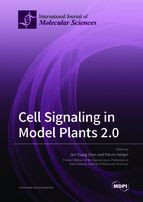Cell Signaling in Model Plants 2.0
A special issue of International Journal of Molecular Sciences (ISSN 1422-0067). This special issue belongs to the section "Molecular Plant Sciences".
Deadline for manuscript submissions: closed (31 March 2022) | Viewed by 81390
Special Issue Editors
Interests: bioactive compounds; chromatography techniques; medicinal plants; phytochemicals; plant biotechnology; plant growth regulators; plant secondary metabolites
Special Issues, Collections and Topics in MDPI journals
Interests: cell signaling; abiotic stresses; functional analysis
Special Issues, Collections and Topics in MDPI journals
Special Issue Information
Dear Colleagues,
This Special Issue is the continuation of our previous special issue "Cell Signaling in Model Plants"
Plants as sessile organisms are not able to move and must respond to adverse environmental conditions/stress such as high salinity, heat, cold, drought, oxidative stress, and pathogen attack. Signal transduction is a complex network of interactions that signal elements (physical and chemical) are transmitted through the plant cell to respond to environmental stimuli. Receptors, protein kinases, transcription factors, intracellular calcium, ROS, and hormones are the main components of signal transduction pathway that regulate or stimulate other cell signal components.
This Special Issue explores the role of signaling components in model plants, such as Antirrhinum, Arabidopsis thaliana, Lotus japonicas, Medicago truncatula, rice, tobacco, and Zea mays, which have led to adaptation and resistance against abiotic and biotic stresses, including but not limited to functional analysis of key genes, hormone contents, signal transduction networks, gene expression profiling, and post-translation modifications.
Dr. Jen-Tsung Chen
Dr. Parviz Heidari
Guest Editors
Manuscript Submission Information
Manuscripts should be submitted online at www.mdpi.com by registering and logging in to this website. Once you are registered, click here to go to the submission form. Manuscripts can be submitted until the deadline. All submissions that pass pre-check are peer-reviewed. Accepted papers will be published continuously in the journal (as soon as accepted) and will be listed together on the special issue website. Research articles, review articles as well as short communications are invited. For planned papers, a title and short abstract (about 100 words) can be sent to the Editorial Office for announcement on this website.
Submitted manuscripts should not have been published previously, nor be under consideration for publication elsewhere (except conference proceedings papers). All manuscripts are thoroughly refereed through a single-blind peer-review process. A guide for authors and other relevant information for submission of manuscripts is available on the Instructions for Authors page. International Journal of Molecular Sciences is an international peer-reviewed open access semimonthly journal published by MDPI.
Please visit the Instructions for Authors page before submitting a manuscript. There is an Article Processing Charge (APC) for publication in this open access journal. For details about the APC please see here. Submitted papers should be well formatted and use good English. Authors may use MDPI's English editing service prior to publication or during author revisions.
Keywords
- hormones profiling
- cell receptors
- abiotic stress
- biotic stress
- transcription factors
- micro RNA
- regulatory elements
- protein kinases
- protein–protein interaction
- cellular responses
- functional genomics
- gene expression
- enzyme activity
- computational biology








